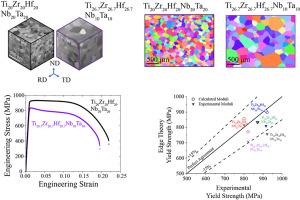Effects of HCP/BCC element ratios on the room-temperature tensile properties of Ti-Zr-Hf-Nb-Ta refractory high-entropy alloys
IF 4.8
2区 材料科学
Q2 CHEMISTRY, PHYSICAL
引用次数: 0
Abstract
Equiatomic and non-equiatomic Ti-Zr-Hf-Nb-Ta refractory high-entropy alloys (RHEAs) were arc melted, homogenized, cold rolled, and recrystallized to produce single-phase, body-centered cubic (BCC), microstructures with weak texture and equiaxed grains 76–199 μm in size. The non-equiatomic alloys had either a 60:40 or 80:20 atomic ratio of hexagonal close-packed (HCP) elements (Ti + Zr + Hf) to BCC elements (Nb + Ta). Alloy compositions were measured after thermomechanical processing to determine the concentrations of the major (substitutional) and minor (interstitial) elements. We investigated how elastic constants and uniaxial tensile properties were affected by changes in the relative concentrations of the constituent elements at fixed HCP:BCC ratios. Yield strengths ranged from 801 to 922 MPa and ultimate tensile strengths from 815 to 933 MPa. Good agreement is obtained between the experimental yield strengths and those predicted by a strength theory based on edge dislocations indicating that the observed compositional effects are due to their effects on shear modulus and volume misfit. Fracture occurred by dimpled rupture with fracture strains of 19.4%–25.7%, but uniform strains were an order of magnitude lower at 1.1%–3.2%, calling into question the useable ductility (prior to necking) of RHEAs considered to be ductile based on their fracture strain. Contrary to predictions in the literature that HCP elements promote ductility, our present results show that increasing the HCP:BCC ratio decreases both the total strain and the uniform strain. Similar trends were not evident in the yield or ultimate strengths; rather, strengths were affected mainly by shear modulus and volume misfit.

HCP/BCC元素配比对Ti-Zr-Hf-Nb-Ta难熔高熵合金室温拉伸性能的影响
对等原子和非等原子Ti-Zr-Hf-Nb-Ta难熔高熵合金(RHEAs)进行电弧熔化、均匀化、冷轧、再结晶,得到织构弱的单相体心立方(BCC)组织,晶粒尺寸为76 ~ 199 μm。非等原子合金的六方密排(HCP)元素(Ti + Zr + Hf)与BCC元素(Nb + Ta)的原子比为60:40或80:20。热处理后测定合金成分,确定主要(取代)元素和次要(间隙)元素的浓度。我们研究了在固定的HCP:BCC比下,组成元素的相对浓度变化对弹性常数和单轴拉伸性能的影响。屈服强度为801 ~ 922 MPa,极限抗拉强度为815 ~ 933 MPa。实验屈服强度与基于边缘位错的强度理论预测结果吻合良好,表明观察到的成分效应是由于它们对剪切模量和体积失配的影响。断裂发生在韧窝断裂,断裂应变为19.4%-25.7%,但均匀应变低一个数量级,为1.1%-3.2%,这让人质疑rhea的可用延性(颈缩之前),根据断裂应变被认为是延性的。与文献预测的HCP元素促进延性相反,我们目前的研究结果表明,增加HCP:BCC比会降低总应变和均匀应变。类似的趋势在屈服或极限强度上不明显;相反,强度主要受剪切模量和体积失配的影响。
本文章由计算机程序翻译,如有差异,请以英文原文为准。
求助全文
约1分钟内获得全文
求助全文
来源期刊

Intermetallics
工程技术-材料科学:综合
CiteScore
7.80
自引率
9.10%
发文量
291
审稿时长
37 days
期刊介绍:
This journal is a platform for publishing innovative research and overviews for advancing our understanding of the structure, property, and functionality of complex metallic alloys, including intermetallics, metallic glasses, and high entropy alloys.
The journal reports the science and engineering of metallic materials in the following aspects:
Theories and experiments which address the relationship between property and structure in all length scales.
Physical modeling and numerical simulations which provide a comprehensive understanding of experimental observations.
Stimulated methodologies to characterize the structure and chemistry of materials that correlate the properties.
Technological applications resulting from the understanding of property-structure relationship in materials.
Novel and cutting-edge results warranting rapid communication.
The journal also publishes special issues on selected topics and overviews by invitation only.
 求助内容:
求助内容: 应助结果提醒方式:
应助结果提醒方式:


